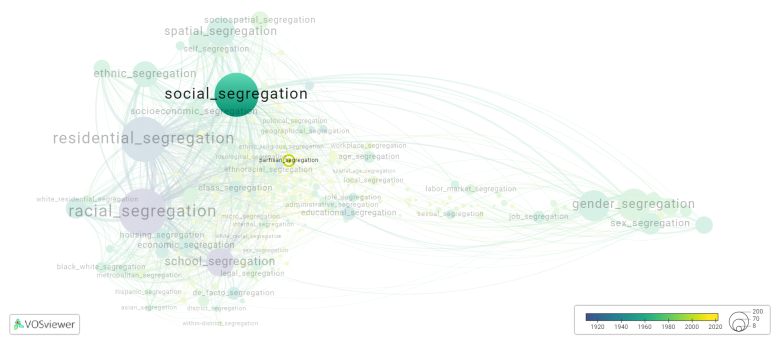Partisan segregation: Difference between revisions
(Creating page) |
(Creating page) |
||
| Line 10: | Line 10: | ||
local residential segregation | local residential segregation | ||
[[partisan_segregation.png|780x780px]] | [[File:partisan_segregation.png|780x780px]] | ||
For the complete network of associated segregation forms, see: | For the complete network of associated segregation forms, see: | ||
clusters https://tinyurl.com/2d8wg5n3 | clusters https://tinyurl.com/2d8wg5n3 | ||
Revision as of 16:35, 25 September 2024
Date and country of first publication[1]
2014
Italy; Denmark
Definition
Partisan segregation refers to the separation or division of individuals based on their political party affiliation. It is the practice of separating people into different groups or communities based on their political beliefs. This can result in a lack of interaction and understanding between individuals with different political views, leading to increased polarization and social divisions. Partisan segregation can be observed in various aspects of society, including residential areas, workplaces, and social media networks, where like-minded individuals tend to surround themselves with others who share similar political ideologies.
See also
Related segregation forms
Partisan segregation is frequently discussed in the literature with the following segregation forms:
local residential segregation
 For the complete network of associated segregation forms, see:
clusters https://tinyurl.com/2d8wg5n3
year of publication https://tinyurl.com/2235lkhw
betweenness centrality https://tinyurl.com/223udk5r
disciplines where segregation forms first appeared https://tinyurl.com/244d8unz
For the complete network of associated segregation forms, see:
clusters https://tinyurl.com/2d8wg5n3
year of publication https://tinyurl.com/2235lkhw
betweenness centrality https://tinyurl.com/223udk5r
disciplines where segregation forms first appeared https://tinyurl.com/244d8unz
References
Notes
- ↑ Date and country of first publication as informed by the Scopus database (December 2023).
At its current state, this definition has been generated by a Large Language Model (LLM) so far without review by an independent researcher or a member of the curating team of segregation experts that keep the Segregation Wiki online. While we strive for accuracy, we cannot guarantee its reliability, completeness and timeliness. Please use this content with caution and verify information as needed. Also, feel free to improve on the definition as you see fit, including the use of references and other informational resources. We value your input in enhancing the quality and accuracy of the definitions of segregation forms collectively offered in the Segregation Wiki ©.
Partisan segregation appears in the following literature
Gnisci A., Van Dalen A., Di Conza A. (2014). Interviews in a Polarized Television Market: The Anglo American Watchdog Model Put to the Test. Political Communication, 31(1), 112-130. https://doi.org/10.1080/10584609.2012.747190
Gimpel J.G., Hui I. (2017). Inadvertent and intentional partisan residential sorting. Annals of Regional Science, 58(3), 441-468. Springer Verlag.https://doi.org/10.1007/s00168-016-0802-5
Weaver I.S., Williams H., Cioroianu I., Williams M., Coan T., Banducci S. (2018). Dynamic social media affiliations among UK politicians. Social Networks, 54(), 132-144. Elsevier B.V..https://doi.org/10.1016/j.socnet.2018.01.008
Dubois E., Blank G. (2018). The echo chamber is overstated: the moderating effect of political interest and diverse media. Information Communication and Society, 21(5), 729-745. Routledge.https://doi.org/10.1080/1369118X.2018.1428656
Wihbey J., Joseph K., Lazer D. (2019). The social silos of journalism? Twitter, news media and partisan segregation. New Media and Society, 21(4), 815-835. SAGE Publications Ltd.https://doi.org/10.1177/1461444818807133
Brown J.R., Enos R.D. (2021). The measurement of partisan sorting for 180 million voters. Nature Human Behaviour, 5(8), 998-1008. Nature Research.https://doi.org/10.1038/s41562-021-01066-z
